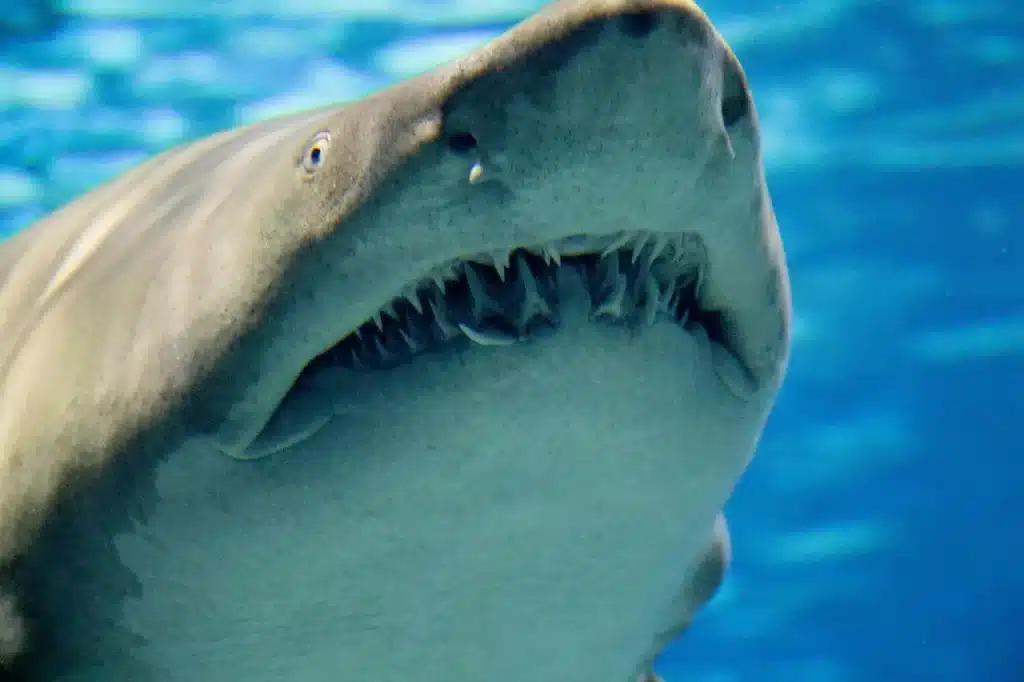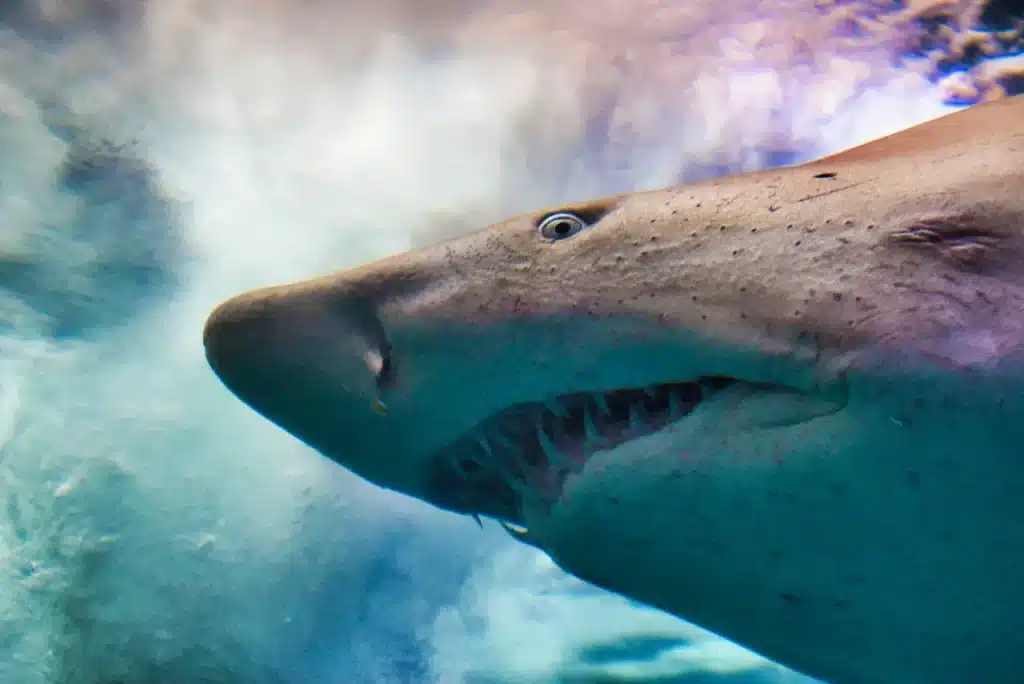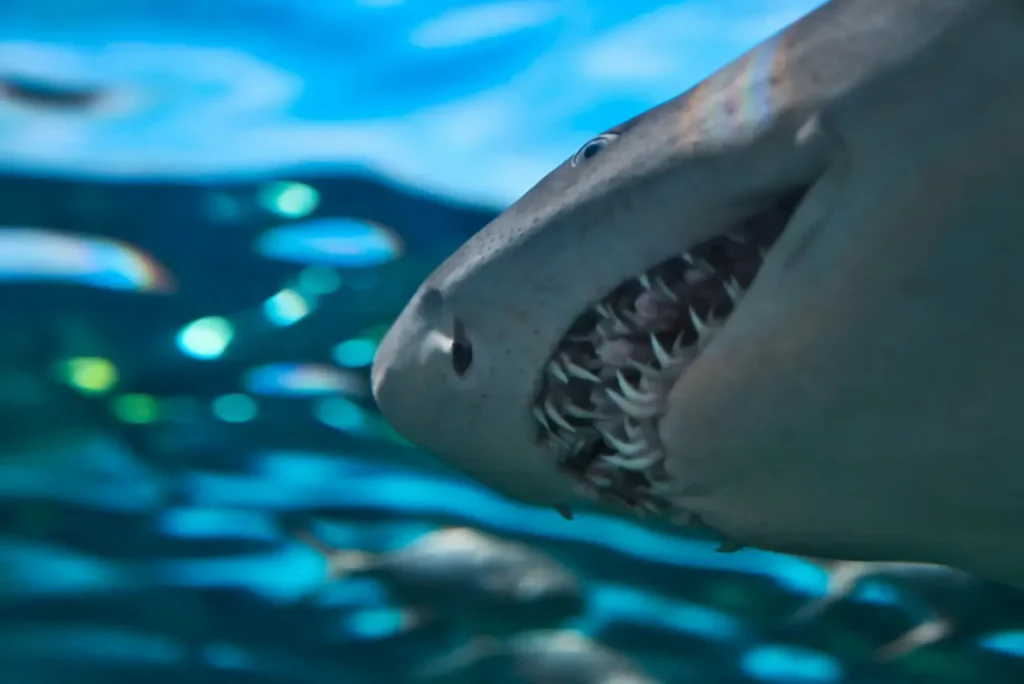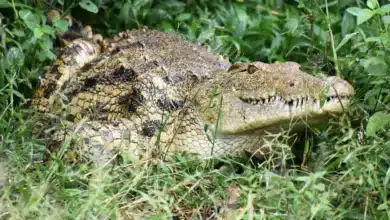A quiet, ancient ceremony takes place along the east coast of South Africa. It is performed beneath the waves. The ritual takes place in murky depths, far from human eyesight. Rules of survival are uncompromising and raw.
Every two years, the ragged tooth shark, a creature both feared and misunderstood, embarks on one of nature’s more mysterious migrations: a 1,500-kilometre journey along the wild and changing edge of the African continent. This is not a journey to escape cold water or for food. This is a journey that requires endurance, instinct and survival – a journey for a mate.
This story follows the migration. It also follows a female shark that lives in captivity, not the open ocean. Her journey begins behind glass, not with a long swim along the coast. Yet, her stakes could be higher.

What Are the Ragged Tooth Sharks (Ragged Tooth Sharks)?
The ragged-tooth shark, also known as Carcharias Taurus, is one of the ocean’s most recognisable predators. They strike a fierce pose with their jagged, protruding teeth. These teeth are visible even when the mouth is closed. It’s not as scary as it seems. Although they look menacing, ragged-tooth sharks are docile and rarely aggressive, unless provoked.
Other parts of the globe call them by other names. In the United States, they are often referred to as sand-tiger sharks. In Australia, these sharks are called grey nurse sharks. They are called “raggies” by divers who live off the coast of South Africa, where the warm Agulhas current runs along the coast.
These sharks have a remarkable ability to survive. These sharks have been around for a million years and have survived oceanic changes, human pressure, and even extinctions. But despite the evolution of their resilience, their breeding is not guaranteed.
The Great Migration: From Cape to KwaZulu
The ragged-tooth sharks migrate up the East Coast of South Africa every two years. The sharks’ journey begins near the Eastern Cape, where the water is cooler and rich in nutrients. It ends at the subtropical waters off KwaZulu-Natal.
Not just because of their curious sharks or vibrant coral reefs, these dive sites are famous around the world. These are breeding grounds. Nurseries. Hidden theatres where the next generation ragged-tooth sharks begin.
Along the way, the sharks pass through dynamic marine environments–estuaries, river mouths, rocky reefs, and deep drop-offs. The sharks follow the currents and sense changes in temperature and salinity. They navigate using an oceanic memory, which still confuses scientists.
The journey of the females is dangerous. The male sharks can be aggressive and violent during the mating process. The rough scars on the flanks of female sharks are a visible reminder of their brutal reproductive system.
Evolution has its reasons.
A Reproductive Strategy Like No Other
The way ragged-tooth sharks reproduce is one of the most fascinating – and brutal – facts about them.
Only two pups can survive in the uterus of a female — one from each side. This does not mean that she gives birth to only two embryos. It’s far from true. She may have up to 12 fertilised eggs per uterus in the early stages. As the strongest embryos develop, they start to eat their weaker brothers and sisters in a form of survival that is known as intrauterine cannibalism.
After a nine- to twelve-month gestation, only two pups are left. They are strong, capable and ready to hunt.
This is the best example of “the fittest” that we can find in the animal kingdom. This means that the ragged-tooth sharks are very low reproducers and their populations are extremely vulnerable due to overfishing or environmental changes.

Human Element: our Coasts and sharks
South Africa’s coast is home to one of the most diverse marine environments on the planet. The warm tropical currents of the north meet the cold upwellings of the south to create a unique marine corridor that supports everything from great white sharks to dolphins.
The ragged-tooth shark is an important part of the ecosystem. They are apex sharks and help maintain balance in the ocean by regulating fish populations.
But they are also vulnerable–particularly along the KwaZulu-Natal coast, where shark nets designed to protect swimmers often trap these creatures unintentionally. Ragged-tooth sharks are often caught in gillnets and trawling operations as bycatch. Although some are tagged, others do not survive.
Here, human conservation is critical. The story of a particular female captive is particularly poignant in this context.
The Captive Female: An Out of Place Shark
A female ragged-tooth shark is seen behind glass in a large aquarium. She’s thousands of kilometres from the ocean. Her world is artificial — filtered water, artificial corals, regulated temperature. Yet, within her, she is a woman with ancient instincts.
She has never experienced the Agulhas current or navigated in the moonlight over a coral reef, but her biology says: It’s time for a mate.
Her behaviour begins to shift. She begins to swim more erratically. Her appetite fluctuates. She bumps into the corners of her tank. She knows exactly what she wants to do, but there’s nowhere to go. No vast underwater highway. No mating ground. No male sharks nearby.
It’s not a matter of life or death for her in the traditional sense, but something more. A sort of biological desire. A calling left unanswered.
Marine biologists and aquarists should be on the lookout. In some cases, hormonal changes in captive sharks may cause complications. Other times, these changes are signs of deeper stress. Many captive animals experience the same tension as her.
She plays an important role even in this place. Visitors can learn about the biology, behaviours of ancient species and survival instincts through her.
Myths and Misconceptions
The public perception of ragged-tooth sharks is the same as that of other shark species, despite their passive nature. They have a bad reputation because of their jagged teeth, slow movement, and eerie appearance.
These sharks are not man-eaters. No fatal attacks by ragged-tooth sharks on humans have been recorded. Divers often swim just metres away from them without incident. Raggies, unlike more aggressive species, are curious and less confrontational.
Media sensationalism and narratives based on fear have contributed to the demonisation of these groups. Perceptions must be changed for conservation to succeed. Education is the key, and part of it comes from eco-tourism, scientific storytelling, and direct engagement.
Conservation in Action – South Africa’s role
South Africa is a leader in shark conservation. Several marine protected areas (MPAs), including iSimangaliso Park and Aliwal Shoal, offer vital sanctuary to ragged tooth sharks in their migration and reproduction seasons.
Researchers have used scientific tagging to track shark movement, assess population health, and understand mating patterns. Eco-tourism diving, where visitors can observe ragged-tooth sharks in their habitat, has replaced harmful fishing methods with sustainable income for local communities.
There are still challenges. Shark populations continue to be affected by climate change, coastal development and unregulated fishing. Each loss of ragged-tooth sharks is important because they reproduce slowly. This is why marine educators and environmentalists say it so often:
“Save a shark and you’ll save a whole generation.”

When Ocean and Instinct collide
The ragged-tooth shark’s migration is a work of poetry, a rhythm composed by currents, gradients in temperature, and evolutionary memory.
Imagine the African sun setting over the continent as you see the shark glide through the coastal waters. The reef is alive below. Above, the tides are controlled by the moon. It is not a choice for the shark. The shark is driven by compulsion, a call etched in her bones.
The same urge is still present in the female captive. Her story reminds us that wildness can still exist even when you are separated from the ocean. Her instincts are the tether that ties her to a world, which is out of reach but never forgotten.
Final Thoughts – The Ocean’s Hidden Storytellers
The ragged tooth shark is a storyteller, even though they do not speak. Their teeth, scars and migrations all speak of ancient rites and coastal landscapes.
They are neither machines nor monsters. These fascinating creatures are caught between ocean changes and human influences. They are not only dependent on temperature and tides, but also on us.
The ragged-tooth shark is a reminder of something important, whether it’s swimming in the wild under the breakers on the Eastern Cape or circling a tank with artificial lights.
Even the most fierce-looking creatures are vulnerable. Every wave has a secret. We’re just beginning to discover the stories that are worth saving.




